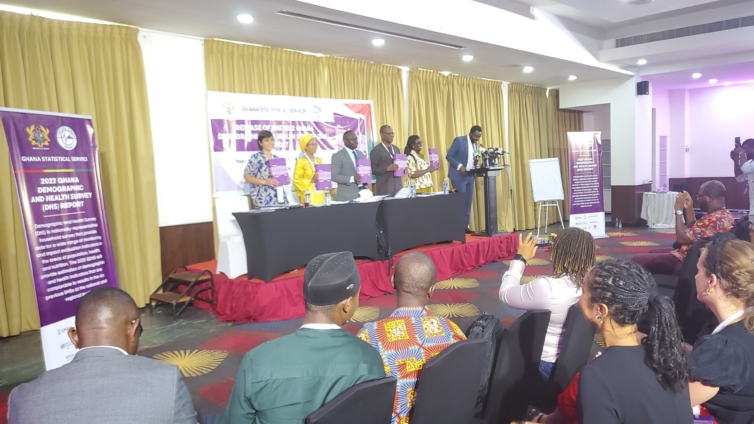A study report published by the Ghana Statistical Service has revealed a decline in the fertility rate from 6.4 children per woman in 1988 to 3.9 in 2022.
On a regional level, fertility ranges from 2.9 children per woman in Greater Accra to 6.6 children per woman in the North East Region.
Women in the lowest wealth bracket have an average of 5.9 children, whereas the average is 2.7.
Professor Samuel Annim, the Government Statistician, disclosed this in Accra during the release of the 2022 Demographic and Health Survey.
The survey is the seventh conducted across the country since 1988, to provide data for monitoring Ghana's population and health situation.
Concerning drinking water, the survey found that 84% of households in Ghana's had access to at least basic drinking water services.

This includes drinking water from an improved source, either on the premises or with a round-trip collection time of less than 30 minutes.
Furthermore, 95 per cent of urban households have access to at least basic drinking water services, compared to 72 per cent of rural households.
The availability of sufficient quantities of drinking water is lowest in the Northern region with 68 per cent and highest in the Upper East and Ashanti regions with 86 per cent.
On menstrual hygiene, the survey found that 88 per cent of women aged 15 to 49 used disposable sanitary pads, nine per cent used cloth, and two per cent used reusable sanitary pads.
Regarding sanitation, the survey indicated that 24 per cent of Ghanaians had access to at least basic sanitation services, implying they used improved facilities which were not shared with other households.
According to the survey, 15 per cent of adolescent women aged 15 to 19 have ever been pregnant, with 11 per cent giving birth, two per cent pregnant at the time of the survey, and four per cent having lost a pregnancy.
Teenage pregnancy rates vary by region, with Savannah reporting six per cent of young women.
Of all pregnancies that ended in the three years preceding the survey, 82 per cent resulted in live births and 18 per cent in pregnancy losses.
In terms of infant mortality, the Survey found that the neonatal mortality rate was 17 deaths per 1,000 live births, with one in every 25 children in the country dying before the age of five.
Since 1988, under-five mortality has declined from 155 deaths per 1,000 live births to the current rate of 40 deaths per 1,000 births.
For malaria prevalence, the survey indicated that nine per cent of the population aged 6 to 59 tested positive for malaria by microscopy and 17 per cent by RDT.
Dr. Patrick Kuma-Aboagye commended GSS for the survey, which he said would help shape health policies and improve societal well-being.
The survey was funded by USAID, UNICEF, UNFPA, the World Bank, the Global Fund, KOICA, the World Health Organisation, and the Foreign, Commonwealth, and Development Office.
A nationally representative sample of 15,014 women aged 15 to 49 from 17,933 households, as well as 7,044 men aged 15 to 49 from half of the selected households, were interviewed.
The survey represents a response rate of 98 per cent of women and 97 per cent of men.
Latest Stories
-
If I speak there will be fire – Salah on Klopp row
25 mins -
Grieving after divorce is normal, but this particular kind of grief isn’t
30 mins -
10 beautifully unexpected ways husbands proposed to their wives
33 mins -
Reality zone with Vicky Wireko: Painting Ghana purple: Be aware, May is month of mental health awareness
38 mins -
Prof Opoku-Agyemang’s integrity is admirable – Inusah Fuseini
52 mins -
Your reign has been a beacon of wisdom – Alan Kyerematen tells Asantehene
53 mins -
Akufo-Addo’s driver wins La Dadekotopon NPP primary
55 mins -
Education Minister must channel resources to rebrand basic public schools into tackling critical needs – Minority
58 mins -
CAFCC: “Dreams need to score early to unsettle Zamalek” – Former Zamalek striker Felix Aboagye
2 hours -
GHS launches mobile app to counter misinformation about vaccines
3 hours -
Election 2024: Care Ghana warns EC of recruiting political actors as Returning Officers
3 hours -
Mohammed Kudus gets 5th Premier League assist as West Ham hold Liverpool
3 hours -
Religious support source of my success – Asantehene
3 hours -
Sierra Leone energy minister resigns over electricity crisis, as power returns to capital
3 hours -
EC accuses Bright Simons, IMANI Africa of peddling falsehood
3 hours

